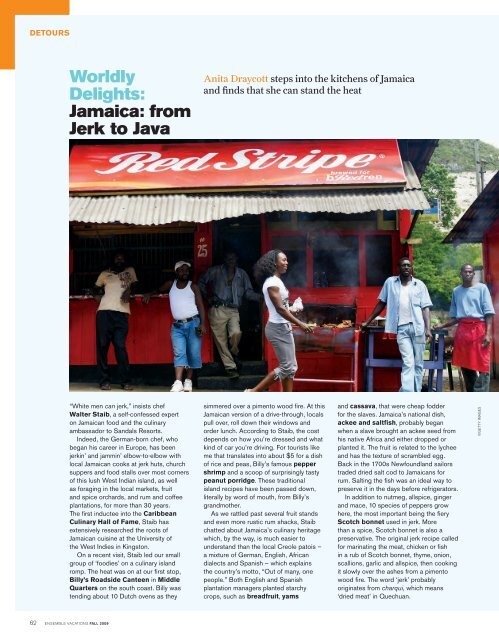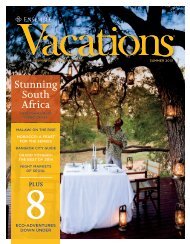Picture - Ensemble Vacations Magazine
Picture - Ensemble Vacations Magazine
Picture - Ensemble Vacations Magazine
- No tags were found...
You also want an ePaper? Increase the reach of your titles
YUMPU automatically turns print PDFs into web optimized ePapers that Google loves.
DETOURS<br />
Worldly<br />
Delights:<br />
Jamaica: from<br />
Jerk to Java<br />
Anita Draycott steps into the kitchens of Jamaica<br />
and finds that she can stand the heat<br />
“White men can jerk,” insists chef<br />
Walter Staib, a self-confessed expert<br />
on Jamaican food and the culinary<br />
ambassador to Sandals Resorts.<br />
Indeed, the German-born chef, who<br />
began his career in Europe, has been<br />
jerkin’ and jammin’ elbow-to-elbow with<br />
local Jamaican cooks at jerk huts, church<br />
suppers and food stalls over most corners<br />
of this lush West Indian island, as well<br />
as foraging in the local markets, fruit<br />
and spice orchards, and rum and coffee<br />
plantations, for more than 30 years.<br />
The first inductee into the Caribbean<br />
Culinary Hall of Fame, Staib has<br />
extensively researched the roots of<br />
Jamaican cuisine at the University of<br />
the West Indies in Kingston.<br />
On a recent visit, Staib led our small<br />
group of ‘foodies’ on a culinary island<br />
romp. The heat was on at our first stop,<br />
Billy’s Roadside Canteen in Middle<br />
Quarters on the south coast. Billy was<br />
tending about 10 Dutch ovens as they<br />
simmered over a pimento wood fire. At this<br />
Jamaican version of a drive-through, locals<br />
pull over, roll down their windows and<br />
order lunch. According to Staib, the cost<br />
depends on how you’re dressed and what<br />
kind of car you’re driving. For tourists like<br />
me that translates into about $5 for a dish<br />
of rice and peas, Billy’s famous pepper<br />
shrimp and a scoop of surprisingly tasty<br />
peanut porridge. These traditional<br />
island recipes have been passed down,<br />
literally by word of mouth, from Billy’s<br />
grandmother.<br />
As we rattled past several fruit stands<br />
and even more rustic rum shacks, Staib<br />
chatted about Jamaica’s culinary heritage<br />
which, by the way, is much easier to<br />
understand than the local Creole patois –<br />
a mixture of German, English, African<br />
dialects and Spanish – which explains<br />
the country’s motto, “Out of many, one<br />
people.” Both English and Spanish<br />
plantation managers planted starchy<br />
crops, such as breadfruit, yams<br />
and cassava, that were cheap fodder<br />
for the slaves. Jamaica’s national dish,<br />
ackee and saltfish, probably began<br />
when a slave brought an ackee seed from<br />
his native Africa and either dropped or<br />
planted it. The fruit is related to the lychee<br />
and has the texture of scrambled egg.<br />
Back in the 1700s Newfoundland sailors<br />
traded dried salt cod to Jamaicans for<br />
rum. Salting the fish was an ideal way to<br />
preserve it in the days before refrigerators.<br />
In addition to nutmeg, allspice, ginger<br />
and mace, 10 species of peppers grow<br />
here, the most important being the fiery<br />
Scotch bonnet used in jerk. More<br />
than a spice, Scotch bonnet is also a<br />
preservative. The original jerk recipe called<br />
for marinating the meat, chicken or fish<br />
in a rub of Scotch bonnet, thyme, onion,<br />
scallions, garlic and allspice, then cooking<br />
it slowly over the ashes from a pimento<br />
wood fire. The word ‘jerk’ probably<br />
originates from charqui, which means<br />
‘dried meat’ in Quechuan.<br />
©GETTY IMAGES<br />
62 ENSEMBLE VACATIONS FALL 2009












